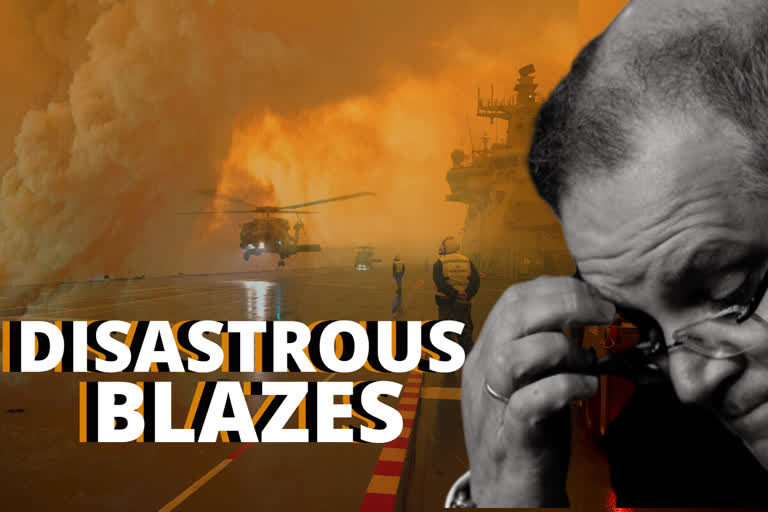Sydney:Catastrophic wildfires have battered Australia hard, at least 25 people have been killed and more than 2,000 homes have been destroyed, which have so far scorched an area twice the size of the US state of Maryland.
Wildfires began in September last year in the Australian states of Queensland and New South Wales have continued into early 2020.
Catastrophic wildfires have battered Australia hard, at least 25 people have been killed and more than 2,000 homes have been destroyed. More than 135 fires are still burning across New South Wales, including almost 70 that were not contained. Officials have warned that the rain won't put out the largest and most dangerous blazes before conditions deteriorate again.
Australian capital Canberra had the worst air quality of any major city in the world for much of Monday. The Department of Home Affairs, which is responsible for coordinating the country’s response to disasters, told all noncritical staff to stay home because of thick smoke choking the city.
Know all about the Australian wildfires. Reasons for the bushfires
Wildfires are common during the southern hemisphere summer, and Australians generally take a pragmatic view of them. But this year’s fires arrived unusually early, fed by drought and the country’s hottest and driest year on record.
Scientists say that there’s no doubt man-made global warming has played a major role in feeding the fires, along with factors like very dry brush and trees and strong winds.
Threaten unique critters on 'Galapagos'
It has been described as Australia's Galapagos Islands and has long been a refuge for some of the country's most endangered creatures. But devastating wildfires over recent days have undone decades of careful conservation work on Kangaroo Island and have threatened to wipe out some of the island's unique fauna altogether.
Dead kangaroos and sheep after wildfires hit the Kangaroo Island, South Australia on Sunday. Experts working on the island say the fires have killed thousands of koalas and kangaroos, and also have raised questions about whether any members of a mouse-like marsupial species that carries its young in a pouch have survived. Similarly, it remains unclear how many from a unique flock of glossy black-cockatoos got away from the flames and whether they have a future on an island where much of their habitat has gone up in smoke.
Located off the coast of South Australia state, Kangaroo Island is about 50% larger than Rhode Island and home to 4,500 people and what was a thriving ecotourism industry. But the wildfires that have been ravaging swaths of Australia have burned through one-third of the island, killing a father and his son and leaving behind a scorched wasteland and a devastated community.
They also have left people scrambling to help the critters that have survived.
Efforts to douse
Australia's government on Monday said that it was willing to pay “whatever it takes” to help communities recover from deadly wildfires that have ravaged the country.
Prime Minister Scott Morrison said that the government was committing an extra 2 billion Australian dollars ($1.4 billion) toward the recovery effort in addition to the tens of millions of dollars that have already been promised.
During operations to assist in battling wildfires, a Royal Australian Navy Seahawk Helicopter departs from HMAS Adelaide while at sea off Australia's east coast on Sunday. The prime minister added that the military was attempting to get food, fuel and water to burned-out communities, and engineers were working to reopen roads and resupply evacuation centres. On Kangaroo Island, a refuge off the coast of South Australia state for some of the country's most endangered creatures, teams had arrived to help euthanize livestock and wild animals injured in the blazes. Hundreds of millions of animals are believed to have died already in the fires across the country.
Meanwhile, heavy smoke was hampering the navy’s efforts to airlift people out of Mallacoota, a coastal town in Victoria cut off for days by fires that forced as many as 4,000 residents and tourists to shelter on beaches over the weekend.
The prime minister’s announcement of relief funds comes as he finds himself under siege for what many Australians have viewed as his lax response to the crisis. On Saturday, he announced he would dispatch 3,000 Army, navy and air force reservists to help battle the fires and committed 20 million Australian dollars ($14 million) to lease firefighting aircraft from overseas.
Read also: Australian PM calls up reservists as fire threats escalate
But the moves did little to tamp down the criticism that Morrison had been slow to act, even as he has downplayed the need for his government to address climate change, which experts say helps supercharge the blazes.
The flight deck of a C-130J Hercules aircraft has a warm glow from wildfires, as they prepare to land at Merimbula airfield to deploy fire and rescue crews on Friday. The environmental group Greenpeace said that the relief funds announced by Morrison were “a drop in the ocean,” given the widespread devastation from the fires.
“Every single cent of that money should be contributed by the coal, gas and oil companies whose carbon pollution has caused the climate crisis that has created these extreme fire conditions, right across the country,” Greenpeace Australia Pacific Head of Campaigns Jamie Hanson said in a statement.
“Slugging everyday taxpayers with the bill for this just adds insult to injury. These big polluters have become rich by trashing our climate and it’s time that they started coughing up for the repair bill," Jamie added.
Read also: Australia orders mass evacuation of fire-ravaged towns before heatwave
